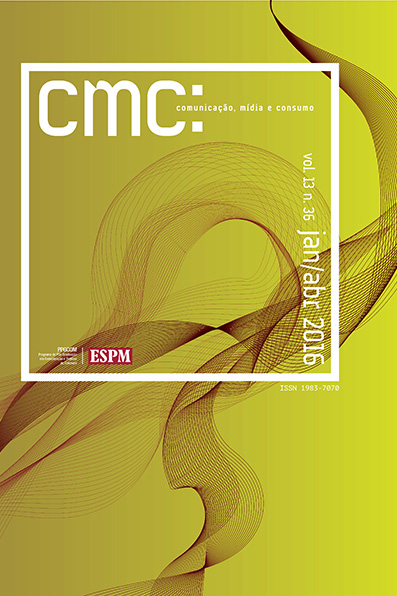Crossing the boundaries of the magic circle: immersion, attention and video games
DOI:
https://doi.org/10.18568/cmc.v13i36.1075Keywords:
Magic circle, Immersion, Attention, VideogamesAbstract
This paper proposes a discussion about the concept of magic circle, which in the last years has been thoroughly debated within the context of games in general and video games in particular. Through a dialogue with authors of the game studies’ field, such as Johan Huizinga and Katie Salen and Eric Zimmerman, as well as authors of cognitive psychology that discuss the issue of attention, we argue that the magic circle, instead of separating fiction and reality – as advocated by several authors – works as a cognitive structure of mediation, whose existence occurs in differentiated and gradual forms, according to immersive and attentional processes that work between player and technological device, in this case the video game.Downloads
References
AARSETH, E. Cybertext. Baltimore: Londres: The Johns Hopkins University Press, 1997.
BROWN, E.; CAIRNS, P. A Grounded Investigation of Game Immersion. In: ACM CONFERENCE ON HUMAN FACTORS IN COMPUTING SYSTEMS (CHI) 2004. Anais… Viena: ACM Press, 2004. p. 1.297-1.300.
CAILLOIS, R. Man, Play and Games. Chicago: University of Illinois Press, 1958.
COHEN, A. Selective Attention. In: ENCYCLOPEDIA OF COGNITIVE SCIENCE. [s.l.]: Nature Publishing Group, 2003. Disponível em: http://atar.mscc.huji.ac.il/~acohenlab/files/ency_final.pdf. Acesso em: 10 jul.
ERMI, L.; MÄYRÄ, F. Fundamental Components of the Gameplay Experience: Analysing Immersion. In: DIGRA 2005 CONFERENCE. Anais… Vancouver: DiGRA, 16-20 jun. 2005.
FRASCA, G. Ludology meets Narratology. Similitude and differences between (video) games and narrative. Ludology.org., 1999. Disponível em: http://www.ludology.org/articles/ludology.htm. Acesso em: 30 jul. 2015.
HUIZINGA, J. Homo Ludens. Boston: Beacon Press, 1938.
INCE, S. Writing for Video Games. Londres: A&C Black, 2006.
JAMES, W. Principles of Psychology. [s.l.], 1890. Disponível em: http://psychclassics.yorku.ca/James/Principles/index.htm. Acesso em: 30 jul. 2015.
JENNETT, C.; COX, A.; CAIRNS, P. Being ‘In the Game’. In: THE PHILOSOPHY OF COMPUTER GAMES CONFERENCE 2008. Anais… Potsdam: Potsdam University Press, 8-10 maio 2008.
JUUL, J. Half-Real. Cambridge, Mass.: The MIT Press, 2005.
JUUL, J. The Magic Circle and the Puzzle Piece. In: THE PHILOSOPHY OF COMPUTER GAMES CONFERENCE 2008. Anais… Potsdam: Potsdam University Press, 8-10 maio 2008.
MACHADO, A. Regimes de Imersão e Modos de Agenciamento. In: XXV CONGRESSO ANUAL EM CIÊNCIA DA COMUNICAÇÃO. Anais… Salvador, 2002.
MIALET, J-P. L’Attention. Paris: Presses Universitaires de France, 1999.
MURRAY, J. Hamlet on the Holodeck. Cambridge, Mass.: The MIT Press, 1997.
PARASURAMAN, R. (Org.). The Attentive Brain. Cambridge, Mass.: The MIT Press, 2000.
SALEN, K.; ZIMMERMAN, E. Rules of Play. Cambridge, Mass.: The MIT Press, 2003.
SUITS, B. The Grasshopper. Toronto: University of Toronto Press, 1978.
TURKLE, S. Always-on/Always on you. The Tethered Self. In: KATZ, J. (Org.). Handbook of Mobile Communication Studies. Cambridge, Mass.: The MIT Press, 2008.
YEE, N. The Proteus Paradox: How Online Games and Virtual Worlds Change Us – And How They Don’t. Londres: Yale University Press, 2014.
Published
How to Cite
Issue
Section
License
Authors retain the copyright and grant the journal the right to first publication, with the work simultaneously licensed under the Creative Commons Attribution License that allows the work sharing with acknowledgment of authorship and initial publication in this magazine.








